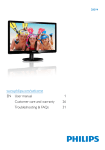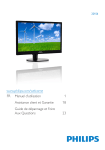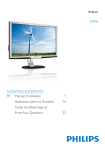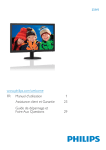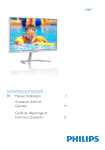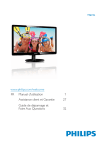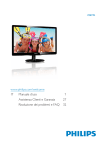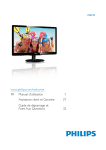Download Philips 163V5LSB23
Transcript
163V5 www.philips.com/welcome EN User manual 1 Customer care and warranty 19 Troubleshooting & FAQs 24 Table of Contents 1. Important ................................................1 1.1 Safety precautions and maintenance...1 1.2 Notational Descriptions .............................2 1.3 Disposal of product and packing material ................................................................3 2. Setting up the monitor .........................4 2.1 Installation ...........................................................4 2.2 Operating the monitor ...............................5 2.3 Remove Base Stand .....................................7 3. Image Optimization...............................8 3.1 SmartContrast .................................................8 3.2 Philips SmartControl Lite ..........................8 4. Technical Specifications ......................15 4.1 Resolution & Preset Modes...................17 5. Power Management ............................18 6. Customer care and warranty ...........19 6.1 Philips’ Flat Panel Monitors Pixel Defect Policy ..................................................19 6.2 Customer Care & Warranty .................21 7. Troubleshooting & FAQs ...................24 7.1 Troubleshooting ...........................................24 7.2 General FAQs ...............................................25 1. Important Please use approved power cord provided by Philips all the time. If your power cord is missing, please contact with your local service center. (Please refer to Customer Care Consumer Information Center) 1. Important This electronic user’s guide is intended for anyone who uses the Philips monitor. Take time to read this user manual before you use your monitor. It contains important information and notes regarding operating your monitor. Do not subject the monitor to severe vibration or high impact conditions during operation. The Philips guarantee applies provided the product is handled properly for its intended use, in accordance with its operating instructions and upon presentation of the original invoice or cash receipt, indicating the date of purchase, dealer’s name and model and production number of the product. Do not knock or drop the monitor during operation or transportation. Maintenance To protect your monitor from possible damage, do not put excessive pressure on the LCD panel. When moving your monitor, grasp the frame to lift; do not lift the monitor by placing your hand or fingers on the LCD panel. 1.1 Safety precautions and maintenance Unplug the monitor if you are not going to use it for an extensive period of time. Warnings Use of controls, adjustments or procedures other than those specified in this documentation may result in exposure to shock, electrical hazards and/or mechanical hazards. Unplug the monitor if you need to clean it with a slightly damp cloth. The screen may be wiped with a dry cloth when the power is off. However, never use organic solvent, such as, alcohol, or ammonia-based liquids to clean your monitor. Read and follow these instructions when connecting and using your computer monitor. To avoid the risk of shock or permanent damage to the set, do not expose the monitor to dust, rain, water, or excessive moisture environment. Operation Please Keep the monitor out of direct sunlight, very strong bright lights and away from any other heat source. Lengthy exposure to this type of environment may result in discoloration and damage to the monitor. If your monitor gets wet, wipe it with dry cloth as soon as possible. If foreign substance or water gets in your monitor, please turn the power off immediately and disconnect the power cord. Then, remove the foreign substance or water, and send it to the maintenance center. Remove any object that could fall into ventilation holes or prevent proper cooling of the monitor’s electronics. Do not block the ventilation holes on the cabinet. Do not store or use the monitor in locations exposed to heat, direct sunlight or extreme cold. When positioning the monitor, make sure the power plug and outlet are easily accessible. In order to maintain the best performance of your monitor and use it for a longer lifetime, please use the monitor in a location that falls within the following temperature and humidity ranges. If turning off the monitor by detaching the power cable or DC power cord, wait for 6 seconds before attaching the power cable or DC power cord for normal operation. 1 1. Important Temperature: 0-40°C 32-95°F 1.2 Notational Descriptions Humidity: 20-80% RH The following subsections describe notational conventions used in this document. Important information for Burn-in/Ghost image. Notes, Cautions and Warnings Always activate a moving screen saver program when you leave your monitor unattended. Always activate a periodic screen refresh application if your monitor will display unchanging static content. Uninterrupted display of still or static images over an extended period may cause “burn in”, also known as “after-imaging” or “ghost imaging”, on your screen. "Burn-in", "after-imaging", or "ghost imaging" is a well-known phenomenon in LCD panel technology. In most cases, the “burned in” or “after-imaging” or “ghost imaging” will disappear gradually over a period of time after the power has been switched off. Throughout this guide, blocks of text may be accompanied by an icon and printed in bold or italic type. These blocks contain notes, cautions or warnings. They are used as follows: Note This icon indicates important information and tips that help you make better use of your computer system. Caution This icon indicates information that tells you how to avoid either potential damage to hardware or loss of data. Warning This icon indicates the potential for bodily harm and tells you how to avoid the problem. Warning Failure to activate a screen saver, or a periodic screen refresh application may result in severe” burn-in” or “after-image” or “ghost image” symptoms will not disappear and cannot be repaired. The damage mentioned above is not covered under your warranty. Some warnings may appear in alternate formats and may not be accompanied by an icon. In such cases, the specific presentation of the warning is mandated by the relevant regulatory authority. Service The casing cover should be opened only by qualified service personnel. If there is any need for any document for repair or integration, please contact with your local service center. (please refer to the chapter of "Consumer Information Center") For transportation information, please refer to "Technical Specifications". Do not leave your monitor in a car/trunk under direct sun light. Note Consult a service technician if the monitor does not operate normally, or you are not sure what procedure to take when the operating instructions given in this manual have been followed. 2 1. Important Taking back/Recycling Information for Customers 1.3 Disposal of product and packing material Philips establishes technically and economically viable objectives to optimize the environmental performance of the organization's product, service and activities. Waste Electrical and Electronic EquipmentWEEE From the planning, design and production stages, Philips emphasizes the important of making products that can easily be recycled. At Philips, end-of-life management primarily entails participation innational take-back initiatives and recycling programs whenever possible, preferably in cooperation with competitors, which recycle all materials (products and related packaging material) in accordance with all Environmental Laws and taking back program with the contractor company. This marking on the product or on its packaging illustrates that, under European Directive 2002/96/EC governing used electrical and electronic appliances, this product may not be disposed of with normal household waste. You are responsible for disposal of this equipment through a designated waste electrical and electronic equipment collection. To determine the locations for dropping off such waste electrical and electronic, contact your local government office, the waste disposal organization that serves your household or the store at which you purchased the product. Your display is manufactured with high quality materials and components which can be recycled and reused. To learn more about our recycling program please visit http://www.philips.com/sites/philipsglobal/ about/sustainability/ourenvironment/ productrecyclingservices.page Your new monitor contains materials that can be recycled and reused. Specialized companies can recycle your product to increase the amount of reusable materials and to minimize the amount to be disposed of. All redundant packing material has been omitted. We have done our utmost to make the packaging easily separable into mono materials. Please find out about the local regulations on how to dispose of your old monitor and packing from your sales representative. 3 2. Setting up the monitor Install base stand 2. Setting up the monitor 1. Place the monitor face down on soft and smooth surface taking care to avoid scratching or damaging the screen. 2.1 Installation 2. Attach/slide the base column with the monitor until it clicks into position. Package contents Register your product and get support at www.philips.com/welcome 163V5 Quick Start 3. Hold the monitor base stand with both hands and firmly insert the base stand into the base column. Power Cable VGA Cable 4 2. Setting up the monitor Connecting to your PC 2.2 Operating the monitor Front view product description D-SUB 3 AC IN AC power input VGA input Kensington anti-theft lock Connect to PC 1. Connect the power cord to the back of the monitor firmly. Description of the On Screen Display What is On-Screen Display (OSD)? 2. Turn off your computer and unplug its power cable. On-Screen Display (OSD) is a feature in all Philips LCD monitors. It allows an end user to adjust screen performance or select functions of the monitors directly through an on-screen instruction window. A user friendly on screen display interface is shown as below: 3. Connect the monitor signal cable to the video connector on the back of your computer. 4. Plug the power cord of your computer and your monitor into a nearby outlet. 5. Turn on your computer and monitor. If the monitor displays an image, installation is complete. Switch monitor’s power ON and OFF. Adjust the brightness level. Adjust the contrast level. Automatically adjust the monitor. Adjust language i Show the imformation Exit OSD 5 2. Setting up the monitor How to adjust OSD with a single key? The OSD Menu 1. The key on the bottom of the front bezel provides dual functions to control power on/ off and OSD menu setting. Below is an overall view of the structure of the On-Screen Display. You can use this as a reference when you want to work your way around the different adjustments later on. Main menu Power off Brightness 0~100 2. Turn on the monitor by pressing the bottom key once. Contrast 0~100 3. Now press the bottom key of front bezel again, to enter the OSD menu. Auto Language 4. You can now select any one of the functions by quickly repeat-pressing the bottom key. The blue box will navigate towards the right as you press the key. You can release the bottom key once the blue box highlights the option you want to choose. Note that the selection is one way loop always moving one direction and then returning at beginning of the menu. English,German,Spanish,Greek, French,Italian,Hungarian,Dutch, Portuguese,Português do Brazil, Russian,Polish,Swedish,Finnish, Türkçe,Czech,Ukrainian,S. Chinese, T.Chinese,Japaness,Korean Information Exit Resolution notification 5. The blue box will remain on the selected function for about 3 seconds and the function icon will flash three times to confirm the choice visible on the 1st layer of the OSD and activate it. This monitor is designed for optimal performance at its native resolution, 1366 × 768 @ 60 Hz. When the monitor is powered on at a different resolution, an alert is displayed on screen: Use 1366 × 768 @ 60 Hz for best results. 6. To select language of your choice please press the bottom key, choose the “Globe” symbol on the OSD menu and let it activate. Multiple options of language will appear on the menu. Repeat press the bottom key again and scroll through the languages. Leaving the blue box on the language of your choice will select and activate it. Physical Function Tilt 7. To adjust brightness or contrast please press the bottom key, choose and activate it. Press the bottom key again to adjust. Note that the selection is one way loop always moving one direction and then returning at beginning of the menu. 6 2. Setting up the monitor 2.3 Remove Base Stand Remove the Base Stand Before you start disassembling the monitor base, please follow the instructions below to avoid any possible damage or injury. 1. Place the monitor face down on a smooth surface, taking care to avoid scratching or damaging the screen. 2. Press the locking clips to detach the base stand away from the base column. 1 3. Detach the base column. 2 7 3. Image Optimization Icon based software is ready to enhance your experience with Philips monitors! 3. Image Optimization Installation 3.1 SmartContrast v Follow the instruction and complete the installation. What is it? v You can launch after installation is completed. A unique technology that dynamically analyzes displayed content and automatically optimizes an LCD monitor's contrast ratio for maximum visual clarity and viewing enjoyment, stepping up backlighting for clearer, crisper and brighter images or dimming backlighting for clear display of images on dark backgrounds. v If you want to launch later, you can either click the shortcut on desktop or toolbar. Why do I need it? You want the very best visual clarity and viewing comfort for every type of content. SmartContrast dynamically controls contrast and adjusts backlighting for clear, crisp, bright gaming and video images or displays clear, readable text for office work. By reducing your monitor's power consumption, you save on energy costs and extend the lifetime of your monitor. First launch -Wizard How does it work? v The first time after installation of SmartControl Lite, it will automatically go to Wizard for first time launch. When you activate SmartContrast, it will analyse the content you are displaying in real time to adjust colors and control backlight intensity. This function will dynamically enhance contrast for a great entertainment experience when viewing videos or playing games. v The wizard will guide you through adjusting your monitor performance step by step. v You can go to Plug-in menu to launch wizard later on as well. v You can adjust more options without wizard by Standard pane. 3.2 Philips SmartControl Lite The new SmartControl Lite software by Phillips allows you to control your monitor via an easy to use on-screen graphic interface. Complicated adjustments are a thing of the past as this user friendly software guides you through finetuning resolution, Color calibration, Clock/Phase adjustments, RGB White point adjustment, etc. Equipped with latest technology in core algorithm for fast processing and response, this Windows 7 compliant eye catching animated 8 3. Image Optimization Start with Standard pane: Adjust menu: v Adjust Menu allow you to adjust Brightness, Contrast, Focus, Position and Resolution. v You can follow the instruction and do the adjustment. v Cancel prompts user if you want to cancel installation. 9 3. Image Optimization Color menu: v Color Menu allow you to adjust RGB, Black Level, White Point, and Color Calibration. v You can follow the instruction and do the adjustment. v Refer to below table for sub-menu item base on your input. v Example for Color Calibration: 10 3. Image Optimization 1. "Show Me" starts color calibration tutorial. 2. Start - starts the 6-step color calibration sequence. 3. Quick View loads the before/after images. 4. To return to Color home pane, click the Cancel button. 5. Enable color calibration - by default is on. If unchecked, does not allow for color calibration to happen, dimes out start and quick view buttons. 6. Must have patent info in calibration screen. First color Calibration Screen: v Displays current preference settings. v A checked box enables the feature. The check box is a toggle. v Enable Context Menu on desktop is checked (On) by default. Enable Context menu displays SmartControl Lite selections for Select Preset and Tune Display in the desktop right-click context menu. Disabled removes SmartControl Lite from the right click context menu. v Previous button is disabled until the second color screen. v Next goes to the succeeding target (6-targets). v Enable Task Tray icon is checked (On) by default. Enable context menu shows the task tray menu for SmartControl Lite. A right click on the task tray icon displays the menu options for Help, Technical Support, Check for Upgrade, About, and Exit. When Enable task tray menu is disabled, the task tray icon will only display EXIT. v Final next goes File>Presets pane. v Cancel closes the UI and returns to the plug in page. Options>Preferences - Will only be active when selecting Preferences from the dropdown Options menu. On a non-supported display capable of DDC/CI, only the Help and Options tabs are available. v Run at Startup is checked (On) by default. When disabled, SmartControl Lite will not launch at start or be in the task tray. The only way to launch SmartControl Lite is either from the desktop short cut or from the program file. Any preset set to run at startup will not load when this box is unchecked (Disabled). v Enable transparency mode (Windows 7, Vista, XP). Default is 0% Opaque. 11 3. Image Optimization On a non-supported display capable of DDC/ CI, only the Help and Options tabs are available. Options>Input - Will only be active when selecting Input from the drop-down Options menu. On a non-supported display capable of DDC/CI, only the Help and Options tabs are available. All other SmartControl Lite tabs are not available. Help>User Manual - Will only be active when selecting User Manual from the drop-down Help menu. On a non-supported display capable of DDC/CI, only the Help and Options tabs are available. v Display the Source instruction pane and current input source setting. v On single input displays, this pane will not be visible. Options>Audio - Will only be active when selecting Audio from the drop-down Options menu. Help>Version - Will only be active when selecting Version from the drop- down Help menu. On a non-supported display capable of DDC/CI, only the Help and Options tabs are available. 12 3. Image Optimization The task tray has five entries: v Help - Access to User Manual file: Open User Manual file using the default browser window. v Technical Support - displays the tech support page. Context Sensitive menu v Check for Update - takes the user to PDI Landing and checks the user’s version against the most current available. The Context Sensitive menu is Enabled by default. If Enable Context Menu has been checked in the Options>Preferences pane, then the menu will be visible. v About - Displays detailed reference information: product version, release information, and product name. v Exit - Close SmartControl Lite. To run SmartControl Lite again either select SmartControl Lite from Program menu, doubleclick the desktop PC icon or restart the system. The Context Menu has three entries: v SmartControl Lite - When selected the About Screen is displayed. v Select Preset - Provides a hierarchical menu of saved presets for immediate use. A check mark shows the currently selected preset. Factory Preset can also be called from the drop down menu. v Tune Display - Opens the SmartControl Lite control panel. Task Tray Menu Disabled When the Task Tray is disabled in the preference folder, only the EXIT selection is available. To completely remove SmartControl Lite Task Tray Menu Enabled The task tray menu can be displayed by rightclicking on the SmartControl Lite icon from the task tray. Left Click will launch the application. 13 3. Image Optimization from the task tray, disable Run at Startup in Options>Preferences. Note All the illustrations in this section are for reference only. SmartControl software version might be changed without notification. Please always check official Portrait website www.portrait.com/dtune/phl/enu/index to download the latest version of SmartControl software. 14 7HFKQLFDO6SHFLÀFDWLRQV 4. Technical Specifications Picture/Display Monitor Panel Type Backlight Panel Size Aspect Ratio Pixel Pitch Brightness SmartContrast Contrast Ratio (typ.) Response Time (typ.) Optimum Resolution Viewing Angle Display Colors Vertical Refresh Rate Horizontal Frequency sRGB Connectivity Signal Input Input Signal Convenience TFT-LCD LED 15.6" W (39.6cm) 16:9 0.252 x 0.252 mm 220 cd/m² 10,000,000:1 500:1 11ms 1366 x 768 @ 60Hz 90° (H) / 50° (V) @ C/R > 10 262K 56Hz - 75Hz 30kHz - 83kHz YES VGA (Analog) Separate Sync, Sync on Green 163V5LSB23 : User Convenience OSD Languages Other Convenience Plug & Play Compatibility English,German,Spanish,Greek,French,Italian,Hungarian,Dutch,Po rtuguese,Português do Brazil,Russian,Polish,Swedish,Finnish, Türkçe,Czech,Ukrainian,S. Chinese,T.Chinese,Japaness,Korean Kensington Lock DDC/CI, sRGB, Windows 8/ Windows 7/ Vista / XP, Mac OSX, Linux Stand Tilt -3 / +10 Power On Mode Sleep (Standby) Off Power LED indicator Power Supply 6.97W (typ.),7.62W (max.) 0.5W 0.5W On mode: White, Standby/Sleep mode: White (blinking) Built-in, 100-240VAC, 50-60Hz 15 7HFKQLFDO6SHFLÀFDWLRQV Dimension Product with stand (WxHxD) Product without stand (WxHxD) Weight Product with stand Product without stand Product with packaging Operating Condition Temperature range (operation) Temperature range (Non-operation) Relative humidity MTBF Environmental ROHS Packaging Cabinet Color Finish 370x298x140 mm 370x237x48 mm 0.94kg 0.79kg 1.766kg 0°C to 40 °C -20°C to 60°C 20% to 80% 30,000hrs YES 100% recyclable Black Texture Note 1.This data is subject to change without notice. Go to www.philips.com/support to download the latest version of leaflet. 16 7HFKQLFDO6SHFLÀFDWLRQV 4.1 Resolution & Preset Modes Maximum Resolution 1366 x 768 @ 60 Hz H. freq (kHz) Resolution V. freq (Hz) 31.47 720 x 400 70.09 31.47 640 x 480 59.94 35 640 x 480 66.67 37.86 640 x 480 72.81 37.5 640 x 480 75 37.88 800 x 600 60.32 46.88 800 x 600 75 48.36 1024 x 768 60 60.02 1024 x 768 75.03 44.77 1280 x 720 59.86 63.89 1280 x 1024 60.02 79.98 1280 x 1024 75.03 47.71 1366 x 768 59.79 Note Please notice that your display works best at native resolution of 1366 x 768 @ 60Hz. For best display quality,please follow this resolution recommendation. 17 5. Power Management 5. Power Management If you have VESA DPM compliance display card or software installed in your PC, the monitor can automatically reduce its power consumption when not in use. If an input from a keyboard, mouse or other input device is detected, the monitor will 'wake up' automatically. The following table shows the power consumption and signaling of this automatic power saving feature: 163V5LSB23: Power Management Definition VESA Mode Video H-sync V-sync Power Used LED Color Active ON Yes Yes 6.97W (typ.) White Sleep (Standby) OFF No No 0.5W (typ.) White (blink) Switch Off OFF - - 0.5W (typ.) OFF The following setup is used to measure power consumption on this monitor. v Native resolution: 1366 x 768 v Contrast: 50% v Brightness: 220 nits v Color temperature: 6500k with full white pattern Note This data is subject to change without notice. 18 6. Customer care and warranty black pixel. Other combinations of lit and dark sub pixels appear as single pixels of other colors. 6. Customer care and warranty Types of Pixel Defects Pixel and sub pixel defects appear on the screen in different ways. There are two categories of pixel defects and several types of sub pixel defects within each category. 6.1 Philips’ Flat Panel Monitors Pixel Defect Policy Philips strives to deliver the highest quality products. We use some of the industry's most advanced manufacturing processes and practice stringent quality control. However, pixel or sub pixel defects on the TFT Monitor panels used in flat panel monitors are sometimes unavoidable. No manufacturer can guarantee that all panels will be free from pixel defects, but Philips guarantees that any monitor with an unacceptable number of defects will be repaired or replaced under warranty. This notice explains the different types of pixel defects and defines acceptable defect levels for each type. In order to qualify for repair or replacement under warranty, the number of pixel defects on a TFT Monitor panel must exceed these acceptable levels. For example, no more than 0.0004% of the sub pixels on a monitor may be defective. Furthermore, Philips sets even higher quality standards for certain types or combinations of pixel defects that are more noticeable than others. This policy is valid worldwide. Bright Dot Defects Bright dot defects appear as pixels or sub pixels that are always lit or 'on'. That is, a bright dot is a sub-pixel that stands out on the screen when the monitor displays a dark pattern. There are the types of bright dot defects. One lit red, green or blue sub pixel. Two adjacent lit sub pixels: - Red + Blue = Purple - Red + Green = Yellow - Green + Blue = Cyan (Light Blue) Pixels and Sub pixels A pixel, or picture element, is composed of three sub pixels in the primary colors of red, green and blue. Many pixels together form an image. When all sub pixels of a pixel are lit, the three colored sub pixels together appear as a single white pixel. When all are dark, the three colored sub pixels together appear as a single Three adjacent lit sub pixels (one white pixel). 19 6. Customer care and warranty Proximity of Pixel Defects Note A red or blue bright dot must be more than 50 percent brighter than neighboring dots while a green bright dot is 30 percent brighter than neighboring dots. Because pixel and sub pixels defects of the same type that are near to one another may be more noticeable, Philips also specifies tolerances for the proximity of pixel defects. Black Dot Defects Black dot defects appear as pixels or sub pixels that are always dark or 'off'. That is, a dark dot is a sub-pixel that stands out on the screen when the monitor displays a light pattern. These are the types of black dot defects. Pixel Defect Tolerances In order to qualify for repair or replacement due to pixel defects during the warranty period, a TFT Monitor panel in a Philips flat panel monitor must have pixel or sub pixel defects exceeding the tolerances listed in the following tables. BRIGHT DOT DEFECTS 1 lit subpixel 2 adjacent lit subpixels 3 adjacent lit subpixels (one white pixel) Distance between two bright dot defects* Total bright dot defects of all types ACCEPTABLE LEVEL 3 1 0 ≥ 15mm 3 BLACK DOT DEFECTS 1 dark subpixel 2 adjacent dark subpixels 3 adjacent dark subpixels Distance between two black dot defects* Total black dot defects of all types ACCEPTABLE LEVEL 5 or fewer 1 or fewer 0 ≥ 15mm 5 or fewer TOTAL DOT DEFECTS Total bright or black dot defects of all types ACCEPTABLE LEVEL 5 or fewer Note 1. 1 or 2 adjacent sub pixel defects = 1 dot defect 20 6. Customer care and warranty 6.2 Customer Care & Warranty For warranty coverage information and additional support requirement valid for your region, please visit www.philips.com/support website for details. You may also contact your local Philips Customer Care Center number listed below. Contact Information for WESTERN EUROPE region: Country CSP Hotline Number Price Opening hours Austria RTS +43 0810 000206 € 0.07 Mon to Fri : 9am - 6pm Belgium Ecare +32 078 250851 € 0.06 Mon to Fri : 9am - 6pm Cyprus Alman 800 92 256 Free of charge Mon to Fri : 9am - 6pm Denmark Infocare +45 3525 8761 Local call tariff Mon to Fri : 9am - 6pm Finland Infocare +358 09 2290 1908 Local call tariff Mon to Fri : 9am - 6pm France Mainteq +33 082161 1658 € 0.09 Mon to Fri : 9am - 6pm Germany RTS +49 01803 386 853 € 0.09 Mon to Fri : 9am - 6pm Greece Alman +30 00800 3122 1223 Free of charge Mon to Fri : 9am - 6pm Ireland Celestica +353 01 601 1161 Local call tariff Mon to Fri : 8am - 5pm Italy Anovo Italy +39 840 320 041 € 0.08 € 0.08 Mon to Fri : 9am - 6pm Luxembourg Ecare +352 26 84 30 00 Local call tariff Mon to Fri : 9am - 6pm Netherlands Ecare +31 0900 0400 063 € 0.10 Mon to Fri : 9am - 6pm Norway Infocare +47 2270 8250 Local call tariff Mon to Fri : 9am - 6pm Poland MSI +48 0223491505 Local call tariff Mon to Fri : 9am - 6pm Portugal Mainteq 800 780 902 Free of charge Mon to Fri : 8am - 5pm Spain Mainteq +34 902 888 785 € 0.10 Mon to Fri : 9am - 6pm Sweden Infocare +46 08 632 0016 Local call tariff Mon to Fri : 9am - 6pm Switzerland ANOVO CH +41 02 2310 2116 Local call tariff Mon to Fri : 9am - 6pm +44 0207 949 0069 Local call tariff Mon to Fri : 8am - 5pm United Kingdom Celestica 21 6. Customer care and warranty Contact Information for CENTRAL AND EASTERN EUROPE region: Country Call center CSP Consumer care number Belarus N/A IBA +375 17 217 3386 +375 17 217 3389 Bulgaria N/A LAN Service +359 2 960 2360 Croatia N/A MR Service Ltd +385 (01) 640 1111 Czech Rep. N/A Asupport 420 272 188 300 Estonia N/A FUJITSU +372 6519900(General) +372 6519972(workshop) Georgia N/A Esabi +995 322 91 34 71 Hungary N/A Profi Service +36 1 814 8080(General) +36 1814 8565(For AOC&Philips only) Kazakhstan N/A Classic Service I.I.c. +7 727 3097515 Latvia N/A ServiceNet LV +371 67460399 +371 27260399 Lithuania N/A UAB Servicenet +370 37 400160(general) +370 7400088 (for Philips) Macedonia N/A AMC +389 2 3125097 Moldova N/A Comel +37322224035 Romania N/A Skin +40 21 2101969 Russia N/A CPS +7 (495) 645 6746 Serbia&Montenegro N/A Kim Tec d.o.o. +381 11 20 70 684 Slovakia N/A Datalan Service +421 2 49207155 Slovenia N/A PC H.and +386 1 530 08 24 the republic of Belarus N/A ServiceBy + 375 17 284 0203 Turkey N/A Tecpro +90 212 444 4 832 N/A Topaz +38044 525 64 95 N/A Comel +380 5627444225 Ukraine Contact Information for China: Country Call center Consumer care number China PCCW Limited 4008 800 008 Contact Information for NORTH AMERICA : Country Call center Consumer care number U.S.A. EPI-e-center (877) 835-1838 Canada EPI-e-center (800)479-6696 22 6. Customer care and warranty Contact Information for APMEA region: Country Australia ASP Consumer care number AGOS NETWORK PTY 1300 360 386 LTD Opening hours Mon.~Fri. 9:00am-5:30pm New Zealand Visual Group Ltd. 0800 657447 Mon.~Fri. 8:30am-5:30pm Hong Kong Macau Company: Smart Pixels Technology Ltd. Hong Kong: Tel: +852 2619 9639 Macau: Tel: (853)-0800-987 Mon.~Fri. 9:00am-6:00pm Sat. 9:00am-1:00pm India REDINGTON INDIA LTD Tel: 1 800 425 6396 SMS: PHILIPS to 56677 Mon.~Fri. 9:00am-5:30pm Indonesia PT. CORMIC SERVISINDO PERKASA Mon.~Thu. 08:30-12:00; +62-21-4080-9086 (Customer Hotline) 13:00-17:30 +62-8888-01-9086 (Customer Hotline) Fri. 08:30-11:30; 13:0017:30 Korea Alphascan Displays, Inc 1661-5003 Mon.~Fri. 9:00am-5:30pm Sat. 9:00am-1:00pm Malaysia R-Logic Sdn Bhd +603 5102 3336 Mon.~Fri. 8:15am-5:00pm Sat. 8:30am-12:30am Pakistan TVONICS Pakistan +92-213-6030100 Sun.~Thu. 10:00am6:00pm Singapore Philips Electronics Singapore Pte Ltd (Philips (65) 6882 3966 Consumer Care Center) Mon.~Fri. 9:00am-6:00pm Sat. 9:00am-1:00pm Taiwan FETEC.CO 0800-231-099 Mon.~Fri. 09:00 - 18:00 Thailand Axis Computer System Co., Ltd. (662) 934-5498 Mon.~Fri. 08:30am~05:30pm South Africa Computer Repair Technologies 011 262 3586 Mon.~ Fri. 08:00am~05:00pm Israel Eastronics LTD 1-800-567000 Sun.~Thu. 08:00-18:00 Vietnam FPT Service Informatic Company Ltd. - Ho Chi Minh City Branch +84 8 38248007 Ho Chi Minh City +84 5113.562666 Danang City +84 5113.562666 Can tho Province Mon.~Fri. 8:00-12:00, 13:30-17:30 Sat. 8:00-12:00 Philippines EA Global Supply Chain Solutions ,Inc. (02) 655-7777; 6359456 Mon.~Fri. 8:30am~5:30pm Armenia Azerbaijan Georgia Kyrgyzstan Tajikistan Firebird service centre +97 14 8837911 Sun.~Thu. 09:00 - 18:00 Uzbekistan Soniko Plus Private Enterprise Ltd +99871 2784650 Mon.~Fri. 09:00 - 18:00 Turkmenistan Technostar Service Centre +(99312) 460733, 460957 Mon.~Fri. 09:00 - 18:00 23 7. Troubleshooting & FAQs 7. Troubleshooting & FAQs Note The Auto Function is not applicable in DVIDigital mode as it is not necessary. 7.1 Troubleshooting Visible signs of smoke or sparks This page deals with problems that can be corrected by a user. If the problem still persists after you have tried these solutions, contact Philips customer service representative. v Do not perform any troubleshooting steps v Disconnect the monitor from mains power source immediately for safety v Contact with Philips customer service representative immediately. Common Problems Imaging Problems No Picture (Power LED not lit) Image is not centered v Make sure the power cord is plugged into the power outlet and into the back of the monitor. v Adjust the image position using the “Auto” function in OSD Main Controls. v First, ensure that the power button on the front of the monitor is in the OFF position, then press it to the ON position. v Adjust the image position using the Phase/ Clock of Setup in OSD Main Controls. It is valid only in VGA mode. No Picture (Power LED is White) Image vibrates on the screen v Make sure the computer is turned on. v Check that the signal cable is properly securely connected to the graphics board or PC. v Make sure the signal cable is properly connected to your computer. v Make sure the monitor cable has no bent pins on the connect side. If yes, repair or replace the cable. Vertical flicker appears v The Energy Saving feature may be activated Screen says v Adjust the image using the “Auto” function in OSD Main Controls. Attention v Eliminate the vertical bars using the Phase/ Clock of Setup in OSD Main Controls. It is valid only in VGA mode. Check cable connection Horizontal flicker appears v Make sure the monitor cable is properly connected to your computer. (Also refer to the Quick Start Guide). v Check to see if the monitor cable has bent pins. v Adjust the image using the “Auto” function in OSD Main Controls. v Make sure the computer is turned on. v Eliminate the vertical bars using the Phase/ Clock of Setup in OSD Main Controls. It is valid only in VGA mode. AUTO button doesn't function v The auto function is applicable only in VGA-Analog mode. If the result is not satisfactory, you can do manual adjustments via the OSD menu. Image appears blurred, indistinct or too dark 24 7 Troubleshooting & FAQs v Adjust the contrast and brightness on On-Screen Display. 7.2 General FAQs Q1: When I install my monitor what should I do if the screen shows 'Cannot display this video mode'? Ans.: Recommended resolution for this monitor: 1366 x 768 @ 60 Hz. An "after-image", "burn-in" or "ghost image" remains after the power has been turned off. v Uninterrupted display of still or static images over an extended period may cause "burn in", also known as "after-imaging " or "ghost imaging", on your screen. "Burnin", "after-imaging", or "ghost imaging" is a well-known phenomenon in LCD panel technology. In most cases, the "burned in" or "after-imaging" or "ghost imaging" will disappear gradually over a period of time after the power has been switched off. v Unplug all cables, then connect your PC to the monitor that you used previously. v In the Windows Start Menu, select Settings/ Control Panel. In the Control Panel Window, select the Display icon. Inside the Display Control Panel, select the 'Settings' tab. Under the setting tab, in box labelled 'desktop area', move the sidebar to 1366 x 768 pixels. v Always activate a moving screen saver program when you leave your monitor unattended. v Open 'Advanced Properties' and set the Refresh Rate to 60 Hz, then click OK. v Always activate a periodic screen refresh application if your LCD monitor will display unchanging static content. v Restart your computer and repeat step 2 and 3 to verify that your PC is set at 1366 x 768 @ 60 Hz. v Severe” burn-in” or “after-image” or “ghost image” symptoms will not disappear and cannot be repaired. The damage mentioned above is not covered under your warranty. v Shut down your computer, disconnect your old monitor and reconnect your Philips LCD monitor. Image appears distorted. Text is fuzzy or blurred. v Turn on your monitor and then turn on your PC. v Set the PC’s display resolution to the same mode as monitor’s recommended screen native resolution. Q2: What is the recommended refresh rate for LCD monitor? Ans.: Recommended refresh rate in LCD monitors is 60 Hz, In case of any disturbance on screen, you can set it up to 75 Hz to see if that removes the disturbance. Green, red, blue, dark, and white dots appears on the screen v The remaining dots are normal characteristic of the liquid crystal used in today’s technology, Please refer the pixel policy for more detail. Q3: What are the .inf and .icm files on the CD-ROM? How do I install the drivers (.inf and .icm)? Ans.: These are the driver files for your monitor. Follow the instructions in your user manual to install the drivers. Your computer may ask you for monitor drivers (.inf and .icm files) or a driver disk when you first install your monitor. Follow the instructions to insert the ( companion CD-ROM) included in this package. The "power on" light is too strong and is disturbing v You can adjust “power on” light using the power LED Setup in OSD main Controls. For further assistance, refer to the Consumer Information Centers list and contact Philips customer service representative. 25 7. Troubleshooting & FAQs Monitor drivers (.inf and .icm files) will be installed automatically. 2. sRGB; this is a standard setting for ensuring correct exchange of colors between different device (e.g. digital cameras, monitors, printers, scanners, etc) Q4: How do I adjust the resolution? Ans.: Your video card/graphic driver and monitor together determine the available resolutions. You can select the desired resolution under Windows® Control Panel with the "Display properties". 3. User Define; the user can choose his/ her preference color setting by adjusting red, green blue color. Q5: What if I get lost when I am making monitor adjustments via OSD? Ans.: Simply press the OK button, then select 'Reset' to recall all of the original factory settings. Note A measurement of the color of light radiated by an object while it is being heated. This measurement is expressed in terms of absolute scale, (degrees Kelvin). Lower Kevin temperatures such as 2004K are red; higher temperatures such as 9300K are blue. Neutral temperature is white, at 6504K. Q6: Is the LCD screen resistant to scratches? Ans.: In general it is recommended that the panel surface is not subjected to excessive shocks and is protected from sharp or blunt objects. When handling the monitor, make sure that there is no pressure or force applied to the panel surface side. This may affect your warranty conditions. Q9: Can I connect my LCD monitor to any PC, workstation or Mac? Ans.: Yes. All Philips LCD monitors are fully compatible with standard PCs, Macs and workstations. You may need a cable adapter to connect the monitor to your Mac system. Please contact your Philips sales representative for more information. Q7: How should I clean the LCD surface? Ans.: For normal cleaning, use a clean, soft cloth. For extensive cleaning, please use isopropyl alcohol. Do not use other solvents such as ethyl alcohol, ethanol, acetone, hexane, etc. Q8: Can I change the color setting of my monitor? Ans.: Yes, you can change your color setting through OSD control as the following procedures, Q10: Are Philips LCD monitors Plug-andPlay? Ans.: Yes, the monitors are Plug-and-Play compatible with Windows 8/ Windows 7/ Vista/XP/NT, Mac OSX, Linux Q11: What is Image Sticking, or Image Burn-in, or After Image, or Ghost Image in LCD panels? Ans.: Uninterrupted display of still or static images over an extended period may cause "burn in", also known as "afterimaging" or "ghost imaging", on your screen. "Burn-in", "after-imaging", or "ghost imaging" is a well-known phenomenon in LCD panel technology. In most cases, the "burned in" or "atter-imaging" or "ghost imaging" will disappear gradually over a period of time after the power has been switched off. Always activate a moving screen saver v Press "OK" to show the OSD (On Screen Display) menu v Press "Down Arrow" to select the option "Color" then press "OK" to enter color setting, there are three settings as below. 1. Color Temperature; The two settings are 6500K and 9300K. With settings in the 6500K range the panel appears "warm, with a red-white color tone", while a 9300K temperature yields "cool, bluewhite toning". 26 7 Troubleshooting & FAQs program when you leave your monitor unattended. Always activate a periodic screen refresh application if your LCD monitor will display unchanging static content. Warning Failure to activate a screen saver, or a periodic screen refresh application may result in severe"burn-in" or "after-image" or "ghost image" symptoms will not disappear and cannot be repaired. The damage mentioned above is not covered under your warranty. Q12: Why is my Display not showing sharp text, and is displaying jagged characters? Ans.: Your LCD monitor works best at its native resolution of 1366 x 768 @ 60 Hz. For best display, please use this resolution. 27 © 2013 Koninklijke Philips Electronics N.V. All rights reserved. Philips and the Philips Shield Emblem are registered trademarks of Koninklijke Philips Electronics N.V. and are used under license from Koninklijke Philips Electronics N.V. Specifications are subject to change without notice. Version: M5163V1T






























